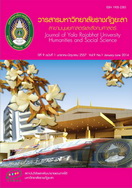สถานการณ์ความปลอดภัยและพฤติกรรมการบริโภคปลาเค็มในจังหวัดยะลา
Main Article Content
บทคัดย่อ
การบริโภคอาหารที่มีการปนเปื้อนอันตรายส่งผลให้เกิดปัญหาความเจ็บป่วยในมนุษย์ งานวิจัยนี้จึงได้ตรวจสอบคุณภาพและความปลอดภัยของผลิตภัณฑ์ปลาเค็มที่จำหน่ายในตลาดของเทศบาลนครยะลา 3 แห่ง ในช่วงฤดูฝน ระหว่างเดือนตุลาคม-พฤศจิกายน พบว่า ปลาเค็มมีคุณภาพดี มีปริมาณ Total volatile bases (TVB) และ Trimethylamine (TMA) อยู่ในช่วง 23.21-33.36 และ 1.75-7.53 mgN/100g ตามลำดับ แต่มีค่า aw สูงกว่าเกณฑ์ ในขณะที่ปริมาณเกลือมีค่าต่ำกว่าเกณฑ์ (ปลาเค็ม, มผช. 312/2549) ผลการตรวจสอบสารเคมีกำจัดแมลงกลุ่มออร์กาโนฟอสเฟตและคาร์บาเมตโดยใช้ชุดทดสอบ “GT” ของกรมวิทยาศาสตร์การแพทย์พบว่า มีการใช้สารเคมีกลุ่มดังกล่าวในผลิตภัณฑ์ปลาเค็มร้อยละ 41.8 แต่ปริมาณที่พบยังอยู่ในระดับปลอดภัย และผลการตรวจสอบทางจุลินทรีย์พบว่า ปริมาณจุลินทรีย์ทั้งหมดในผลิตภัณฑ์ปลาเค็มเกินเกณฑ์ ซึ่งแสดงถึงการจัดการด้านคุณภาพและความปลอดภัยของผลิตภัณฑ์ที่ไม่เหมาะสมทั้งในขั้นตอนการผลิตและการจำหน่าย ผลจากการสำรวจพฤติกรรมการบริโภคผลิตภัณฑ์ปลาเค็มของประชาชนในจังหวัดยะลา จำนวน 343 คน พบว่า ผู้บริโภคส่วนใหญ่ชอบรับประทานปลาอินทรีมากที่สุด (ร้อยละ 30) รองลงมาคือ ปลาหลังเขียว (ร้อยละ 19.5) และปลาทูแขกมีคะแนนความชอบเท่ากับปลาสลิด (ร้อยละ 13.7) การตัดสินใจซื้อจะให้ความสำคัญกับเรื่องรสชาติและกลิ่นเป็นหลัก และมักซื้อปลาเค็มที่ไม่ผ่านการปรุง (ร้อยละ 82.5) การรับทราบข่าวสารเรื่องความปลอดภัยอาหารที่เกี่ยวข้องกับผลิตภัณฑ์ปลาเค็มของประชาชนในจังหวัดยะลามีจำนวนใกล้เคียงกันระหว่างทราบข่าว ร้อยละ 56.6 และไม่ทราบข่าวร้อยละ 43.4 โดยทราบข่าวผ่านทางสื่อโทรทัศน์มากที่สุด (ร้อยละ 45.4) และมีวิธีสังเกตการใช้ยาฆ่าแมลงในปลาเค็มจากการที่มีหรือไม่มีแมลงวันตอม (ร้อยละ 52.2) และมีผู้ตอบแบบสอบถามระบุว่านำปลาเค็มไปปรุงทันทีโดยไม่ผ่านการล้างถึงร้อยละ 12 ดังนั้นการให้ความรู้ด้านความปลอดภัยอาหารแก่ประชาชนเป็นสิ่งจำเป็นที่หน่วยงานที่เกี่ยวข้องต้องเร่งดำเนินการ
Article Details
บทความ ข้อมูล เนื้อหา รูปภาพ ฯลฯ ที่ได้รับการเผยแพร่ในวารสารมหาวิทยาลัยราชภัฏยะลานี้ ถือเป็นลิขสิทธิ์ของวารสารมหาวิทยาลัยราชภัฏยะลา หากบุคคลหรือหน่วยงานใดต้องการนำทั้งหมดหรือส่วนหนึ่งส่วนใดไปเผยแพร่ต่อหรือกระทำการใดๆ จะต้องได้รับอนุญาตเป็นลายลักษณ์อักษรจากวารสารมหาวิทยาลัยราชภัฏยะลาก่อนเท่านั้น
References
2.นิธิยา รัตนาปนนท์. (2553). เคมีอาหาร. กรุงเทพฯ : โอเดียนสโตร์.
3.นิอร โฉมศรี. (2555). จุลชีววิทยาอาหาร. เชียงใหม่ : เชียงใหม่ปรินท์ติ้ง.
4.ปลาเค็ม. (2547). มาตรฐานผลิตภัณฑ์ชุมชน (มผช. 312/2547). กระทรวงอุตสาหกรรม.
5.พบยาแมลงโผล่ปลาร้า-ปลาแห้ง. (2554). สำนักงานกองทุนสนับสนุนการเสริมสร้างสุขภาพ.[ออนไลน์]. ค้นเมื่อ 15 มกราคม 2554, จาก : http://www.thaihealth.or.th/healthcontent/news/12841
6.แมลงวันไม่ตอม ปลาร้าปลาเค็ม สัญญาณอันตราย. [ออนไลน์]. ค้นเมื่อ 11 มกราคม 2553, จาก : http://www.khonkaen4u.com/forum/archiver/?tid-4304.html
7.มัทนา แสงจินดาวงษ์. (2548). ผลิตภัณฑ์ประมงของไทย. กรุงเทพฯ : มหาวิทยาลัยเกษตรศาสตร์.
8.รังสินี โสธรวิทย์. (2550). เคมีและจุลชีววิทยาเบื้องต้นของอาหาร. กรุงเทพฯ : มหาวิทยาลัยเกษตรศาสตร์.
9.วงศ์วิวัฒน์ ทัศนียกุล และสุพัตรา ปรศุพัฒนา. (2551). อาหารปลอดจากสารพิษ. กรุงเทพฯ : กองการแพทย์ทางเลือก กรมพัฒนาการแพทย์แผนไทยและการแพทย์ทางเลือก.
10.สมใจ ศิริโภค. (2550). จุลชีววิทยาอุตสาหกรรม. กรุงเทพฯ : ศูนย์สื่อเสริมกรุงเทพ.
11.สุทธวัฒน์ เบญจกุล. (2548). เคมีและคุณภาพสัตว์น้ำ. กรุงเทพฯ : โอเดียนสโตร์.
12.Antonios, E., Goulas, M. and Kontominas, G. (2007). Combined effect of light salting, modified atmosphere packaging and oregano essential oil on the shelf-life of sea bream (Sparus aurata): biochemical and sensory attributes. J. Food Chemistry, 00, 287- 296.
13.Asli, M. and Morkore, T. (2012). Brines added sodium bicarbonate improve liquid retention and sensory attributes of lightly salted Atlantic cod. J. Food Sci. Technol., 46, 196-202.
14.Bhuiyan, M. N. I., Bhuiyan, H. R. and Nath, K. K. (2009). Incidence of organochlorine insecticides (DDT and Heptachlor) in Bangladeshi dry fish: Seasonal trends and species variability. Afr. J. Environ. Sci. Technol., 3 (11), 405-411.
15.Basti, A. A., Misaghi, A., Salehi, T. Z. and Kamkar, A. (2006). Bacterial pathogens in fresh, smoked and salted Iranian fish. J. Food control, 17, 183-188.
16.Bellagha, S., Ammami, E., Farhat, A. and Kechaou, N. (2002). Drying kinetics and characteristic drying curve of light salted sardine (Sardinella aurita). Drying Technol., 20 (7), 1527-1538.
17.Bras, A. and Costa, R. (2010). Influence of brine salting prior to pickle salting in the manufacturing of various salted-dried fish species. J. food. Engineering, 100, 490-495.
18.Connell, J. J. (1975). Control of Fish Quality. Famham: Fishing News Books Ltd.
19.Choulira, I. N., Savvaidis, N., Panagiotakis, M. and Kontominas, G. (2004). Preservation of salted, vacuum-packaged, refrigerated sea bream (Sparus aurata) fillets
by irradiation: microbiological, chemical and sensory attributes. J. Food Microbiol., 21, 351-359.
20.Chinese-style salted fish. (1993). IARC Monograph-100E, 501-524.
21.Immaculate, J., Sinduja, P. and Jamila, P. (2012). Biochemical and microbial qualities of Sardinella fimbriata sun dried in different methods. IFRJ, 19(4), 1699-1703.
22.Jamila, P. and Govindan, R. (2009). Qualities of commercially and experimentally sundried fin fish, Scomberoides tol. Afr. J. Food Sci., 3(11), 299-302.
23.Kristin, A. P., Ingebrint, B. and Sigurion, A. (2010). Production of Salted Fish in the Nordic Countries Variation in Quality and Characteristics of the Salted Products. Icelandic: Food and Biotech R&D.
24.Meiberg, J. B. M. and Harder, W. (1978). Aerobic and anaerobic metabolism of trimethylamime, dimethylamine and methylamine in hyphomicrobium. J. General Microbol., 106, 265-276.
25.Marrakchi, E., Bennour, A.M., Bouchrit, N. Hamama, A. and Tagafait, H. (1990). Sensory, chemical andmicrobiological assessments of Moroccan sardines (Sardina pilchardus) stored in ice. J. Food Protection, 53, 600-605.
26.Ogbonnaya, C. (2009). Influences of drying methods on nutritional properties of Tilapia fish (Oreochromis nilotieus). World J. Agric. Sci, 5(2), 256-258.
27.Resa, M. S., Azimuddin, K. M., Islam, M. N. and Kamal, M. (2006). Influence of ice storage on raw materials for the production of high quality dried fish products. J. Biol. Sci., 6 (1), 130-134.
28.Simple fish-drying racks improve livelihoods and nutrition in Burundi. (2005). FAO.

